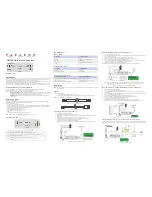
AV6A 15
1 turn is provided in the least-significant bits. Multiturn data is
provided directly “above” the single turn data, bitwise. Example: 12
bit turns x 12 bits/turn encoder, lowest 12 bits = position within one
turn, next 12 bits (up to bit 24) represent turns position data, most
significant 8 bits unused.
Profile 4.0: data is left-justified within Position 1 register: Multi-turn
data is provided in the most-significant bits. Singleturn/data within
one turn is provided directly “below” the multiturn data, bitwise.
Example: 12 bit turns x 12 bits/turn encoder, lowest 8 bits unused,
next 12 bits (up to bit 20) = position within one turn, next 12 bits (up
to bit 32) represent turns position data.
Profile 4.1: data is right-justified: Single-turn data/data within
1 turn is provided in the least-significant bits. Multiturn data is
provided directly “above” the single turn data, bitwise and fills
entire remaining number of bits. Example: 12 bit turns x 12 bits/
turn encoder, lowest 12 bits = position within one turn, next 20 bits
represent turns position data.
Setting (Zero) Position for Multiturn Encoders and Single turn
Encoders:
This can be done manually via the master/scanner software, or via
programmed code in the master device:
Use manufacturer-specific telegram 860: (all data little-Endian)
Data from encoder: 32 bits UDINT, Position, 32 bits UDINT Velocity
Data to encoder: 32 bits: bit 32 = 1, set preset/zero position, bits
1-31 = preset value.
Alternatively, set bit 11 of Control Word (ID=9) = 1.
Setting Direction of Rotation for Count Up/Down:
Parameter Code Sequence (from the GSDML file) contains a
Direction Counting Toggle for the count direction. Use the Online
Parameters tab to change the value. Note that this is REVERSED
from standard Avtron nomenclature--the encoder is viewed from the
front.
Setting Polling, Cyclic, Sync, and Implicit Messaging Mode
Polling, cycling, sync, and implicit messaging modes are supported
by the encoder; use the parameters supplied in the GSDML file to
set the appropriate mode. Store the resulting configuration into the
scanner module.
Storing/Saving Encoder Parameters to EEPROM
To store the current encoder operating parameters into non-volatile
memory:
Other Parameters
Contact Nidec Avtron for additional parameters, diagnostic registers,
cam and programmable limit switch functionality and other
advanced features.
PROFINET IO/ PROFIDRIVE TROUBLESHOOTING
Viewing on oscilliscope: for Profinet IO/Profibus IRT the transmit and
receive signal pairs should change state rapidly as the controller
transmits messages to the encoder and the encoder replies.
Transmission rates vary, but these messages can be extremely short
and typically require scope triggering to spot them.
A simple one-to-one connection can be made to an ordinary PC.
Connect the PC to the encoder using standard (not cross-patch)
cable. Power the encoder using the power connector. The encoder
Link 1 should illuminate green. Use the Ping command, Run “ping
xxx.xxx.xxx.xxx” where xxx represents the IP address that has
been assigned to the encoder. The encoder should reply, and the
communication “ping” time will be reported by the PC. The Active 1
LED should flash briefly during the communication.
A software “snoop” or “sniffer” program can also be used to packet-
analyze the communication.
If the position is changing as the encoder moves, but is reported
incorrectly, the Preset parameter may have been loaded into the
encoder at the wrong physical position of the machine. Drive the
machine to the home/preset position, and cycle power to see if the
position is correctly reloaded.
Profinet IO Diagnostic LEDs
LED
Status
Meaning
Stat 1
Stat 2
Link 1
Green
Off
Green
Input connected to Ethernet, power
OK, node address ok, no Ethernet
errors, encoder operational, Profinet IO
connection established
Link 2
Green
Output connected to next encoder
Stat 2
Flashing
Red
IP address established, but no Profinet IO
connection established
Active 1 Flashing
Yellow
Active inbound communication
Active 2 Flashing
Yellow
Active communication to next encoder















































